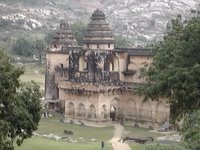
I haven't been to Tirupathi, the abode of lord Venkatesha in AP, that often. The last time I was there was in 1997 and before that in 1992. Tirupathi is a good 5 to 6 hour drive from my hometown of bangalore. The road passing thru some quaint little villages in AP. One thing that caught my attention was a diapalated old castle with all the works. An outer wall with cannon slots and a moat. As these sighting were thru a speeding car window, I had formed a vague image in my mind. (The view to the road)
Thru the ages, that image transformed itself into a simulacrum of India in the middle ages. I had built up my own version of the forts history. Starting from beautifull and ornate chambers, barracks and a dungeon. But time had taken its toll and these images were buried deep in my mind and were wanting to be satisfied. I decided to take a break from work and head to India for some time with my family and friends. Thats when my folks planned a trip to tirupathi. This was an ideal time to visit tirupati as the weather was good and I had unfinished business.
On our way back, I saw Chandra Giri ("Moon Mountain" when translated literally) in the distance. This got me sitting on the edge of my seat and absorbing the view. Trying to get the details and compare them with what I had built in my mind.

This place is really breathtaking. It has so much history built into, starting from the 10th Century AD. (A sculpture damaged by Hyder Ali's invasion. Also notice the roof design. The castle was redesigned by Hyder Ali)
Here is a little history about the fort:
It is believed to be have built about 1000AD by Immadi Narasimha Yadavaraya, a Karvetinagara chieftain of Narayanavaram. It was considerably improved by the Vijayanagara rulers. After the battle of talikota in 1565, chandragiri became the third capital of the declining Vijayanagara Empire in 1592. It came under the control of Hyder Ali in 1782 and was under Mysore till the treaty of Srirangapatinam in 1792 after which the British took over. This site was also witness to the signing of the document relating to the grant of fort St. George to the British East India Company.

The Mahals inside are from the time of Vijayanagara Empire and is a fine example of Indo-Saracenie Architecture. (The other view)
The central durbar has occupied two stories and is crowned by Dravida Vimana. The floors were supported by massive pillars in groups, carrying cross arches with square coffered ceilings. The entire construction is made of stone and brick in mortar. No timber is used. The entrance faces hills on the north while the balconies and windows on the south over looking the extensive grounds where perhaps the troops paraded.


The rani mahal (-->) was a separate quaters for the queens with a bath. And the gallows (<--) was located on top of the hill.
This trip to tirupati and the visit to chandra giri was really good and worth the effort involved. It was really educational and gave me a lot of insights on the life in those times. The mahal now houses a museum with priceless art from chandra giri and surrounding places. It also has arms used in those days. The Archeological Society of India has done a good job in maintaining this historic site. This trip reminded me what Patrick Hazard said once "History in our kind of society is not a luxury but a necessity". Until my next trip....